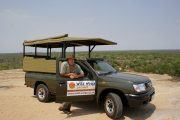In trying to compete with the Big 5 mammal species, the Kruger Park also made a Big 6 birding list. These birds are listed due to their rarity and vulnerability on the endangered list. Unlike the Big 5, the Big 6 is hardly obtainable, because it contains birds like Pel’s Fishing Owl. There are only a handful of breeding pairs found in the park (mainly in the north) and most people can go a lifetime to the park without seeing one. It’s understandable then that it’s on the endangered list. I have come up with my own list of Big Birds – 10 in total. These are some of the biggest or most impressive birds of its kind (of which many are rare and found on the endangered list). They are great to see and a challenge to find. Although chances are slim that you’ll find all of them on one safari, it can be done. I’ve proven that a few times in the past and on one of my recent safaris managed it again.
So here is my list:
1. Ostrich
2. Lappetfaced Vulture
3. Martial Eagle
4. Secretary Bird
5. Giant Eagle Owl
6. Ground Hornbill
7. Kori Bustard
8. Saddlebilled Stork
9. Goliath Heron
10. Giant Kingfisher
So, here is my challenge to you, and especially to the birders out there. If you want to be birding big, try to find these birds on your next safari.
Happy Birding!
Simon Vegter
Wild Wings Safaris
+(Medium)-778276.jpg)
+(Medium)-707261.jpg)
+(Medium)-707487.jpg)


